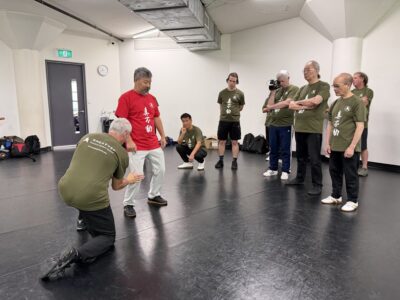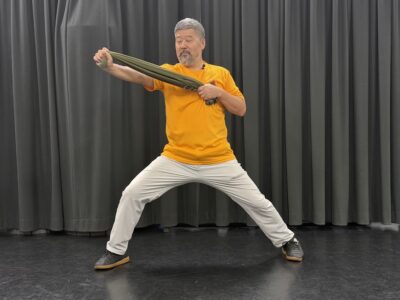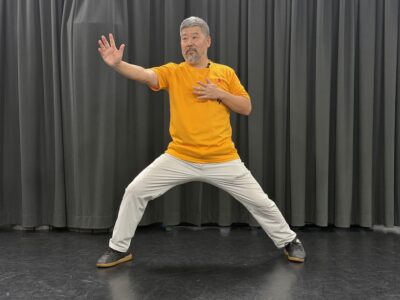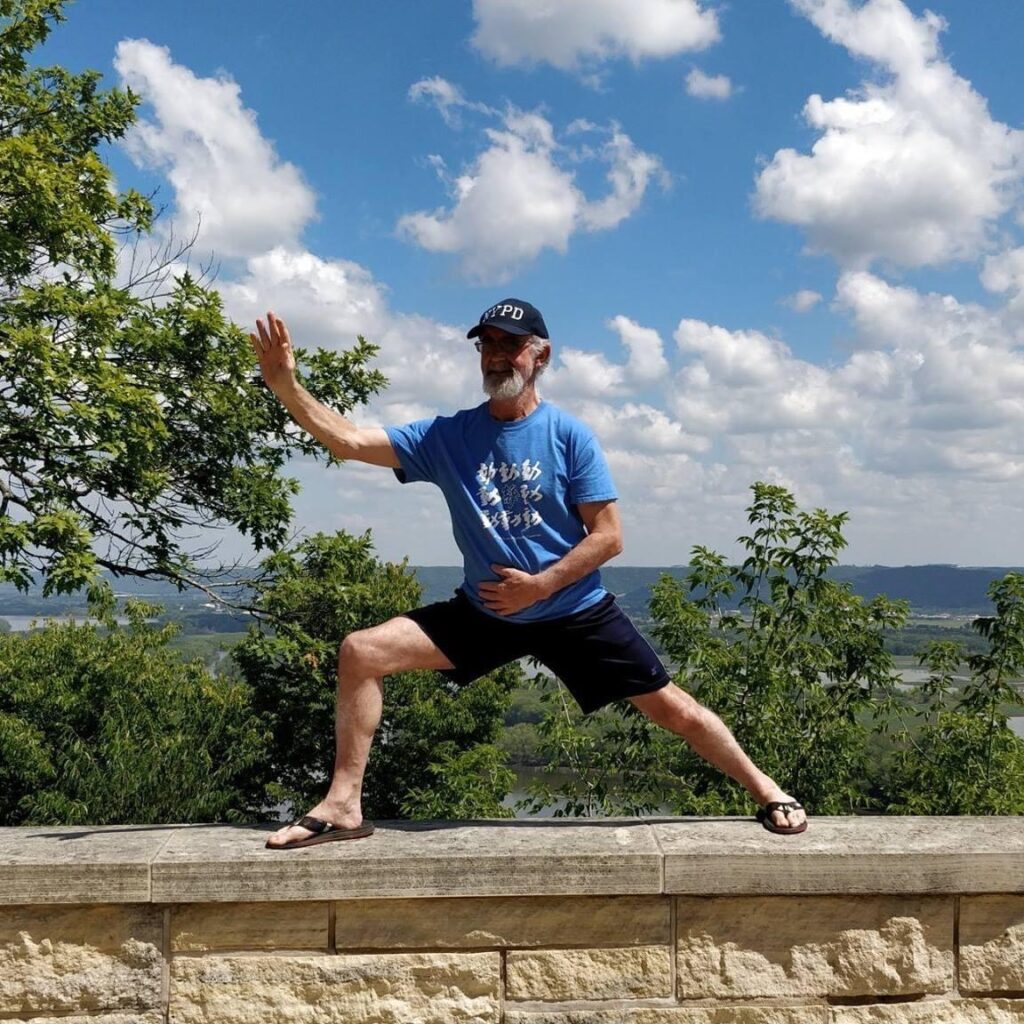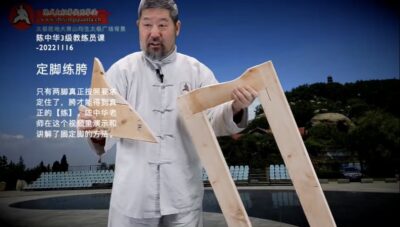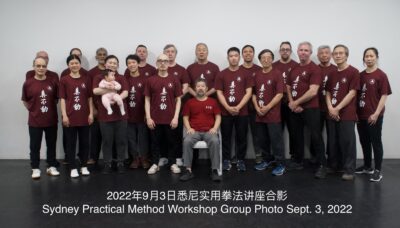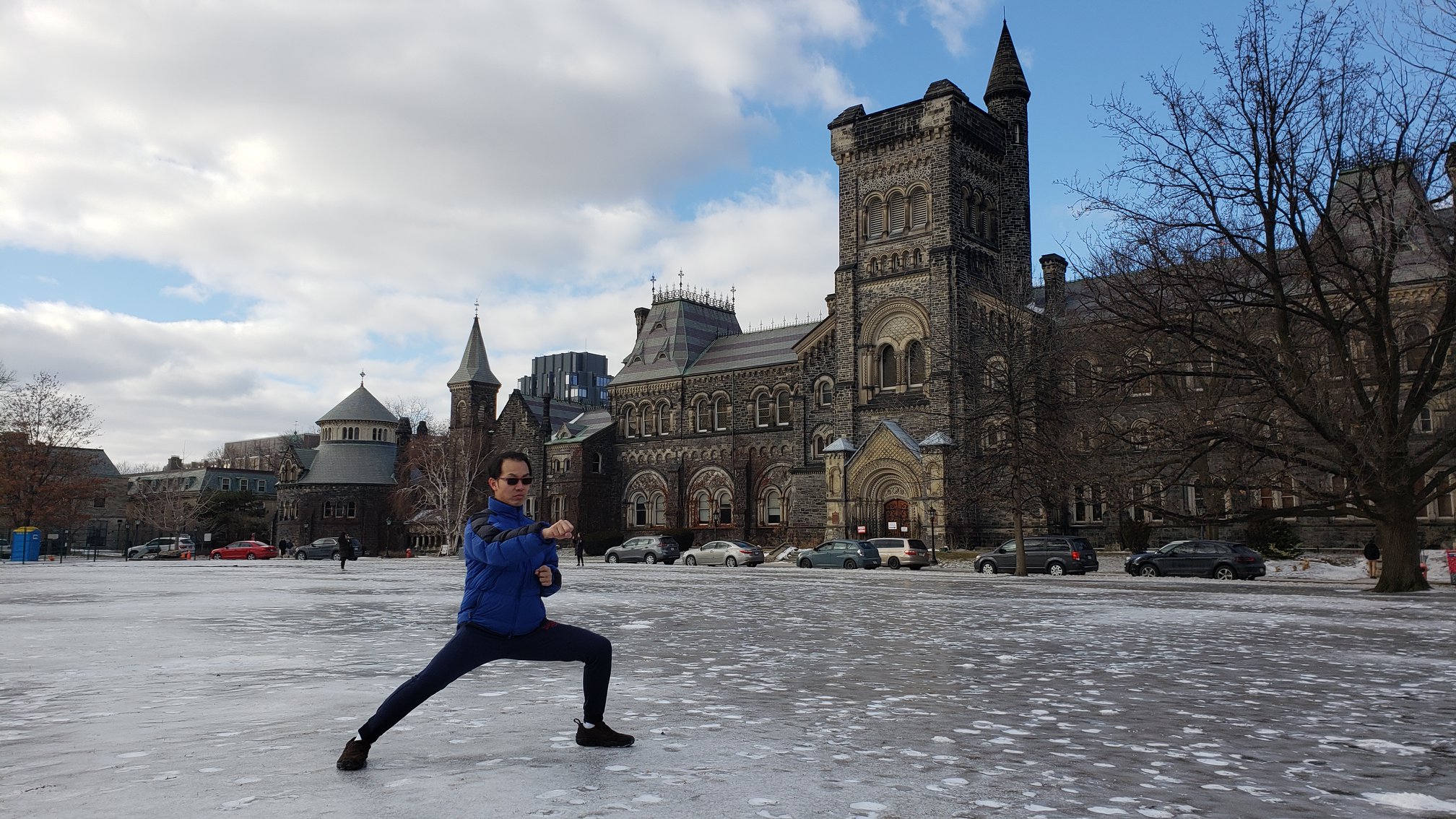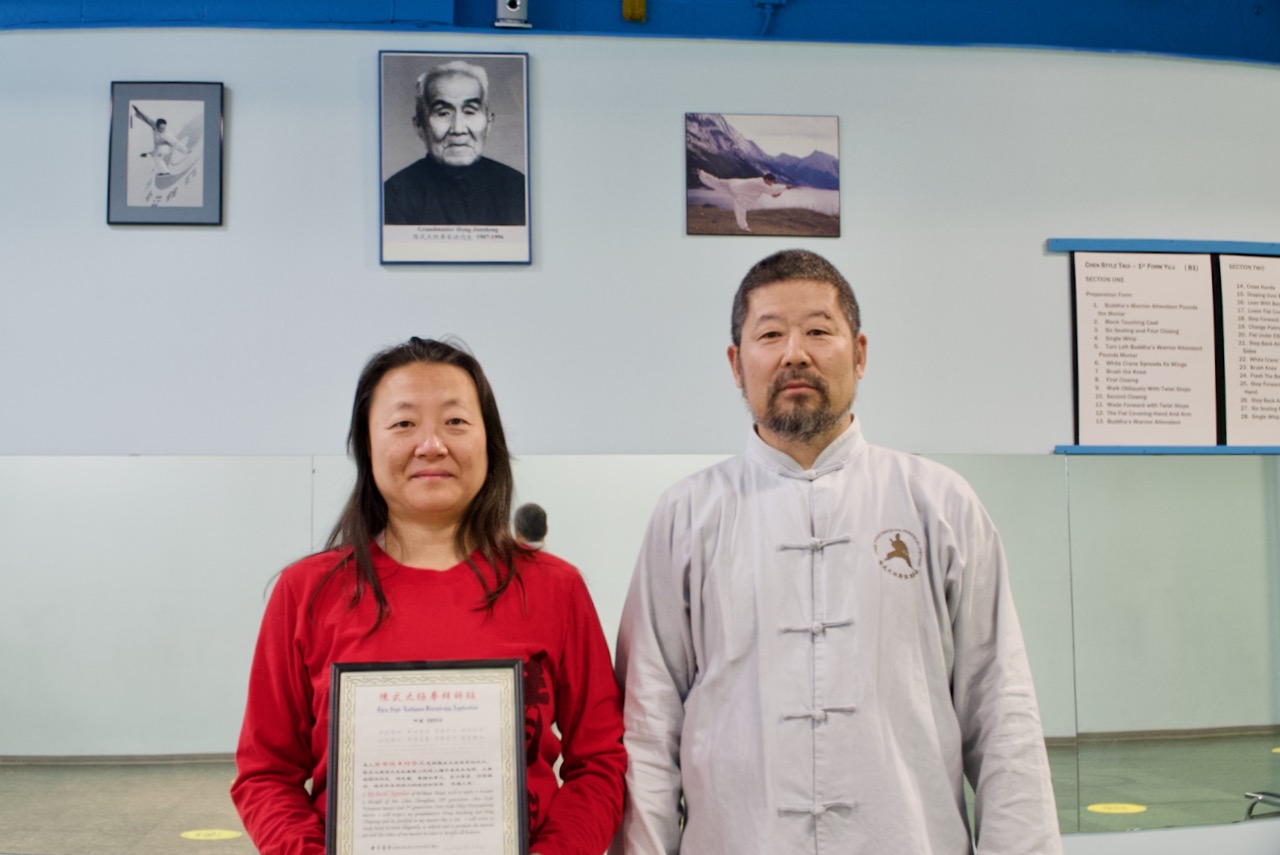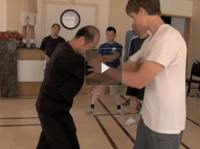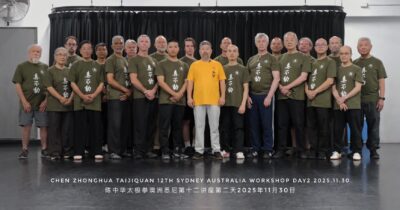
-
Exercise. Both hands fixed on a horizontal pole. Adjust your vertical height to find the middle. Use one finger on each hand and your middle to activate the pull.
-
Train it and find it in your form so you are automatically in that position.
-
He 合 means everything can link to the hub (bicycle wheel).
-
In with elbow. Isolate until two dots interact. Elbow, head.
-
When your body has a three point engagement, it’s a rotation.
-
What is to do it? It must be real.
-
Exercise. Use two ends to crush the middle into one dot. It is a suction feeling.
-
Exercise. Squeeze partner’s hand to He. One push, one pull. Do not move it.
-
Exercise. Produce a line, move 90 degrees to it. The key is how steady.
-
Exercise. Fix hands and shoulders. Rotate the elbows.
-
Exercise. Touch. Get in position. Activate (fingers). Move as one piece (rear foot into kua).
-
Experiment. Get a straight rod. Try to pull it evenly across the floor. Find the middle.
-
Fix onto their front kua (assuming this is their non moving dot). Stretch around this dot.
-
I worked on a move with Rory. Sink the chest in, drop down, and stretch the L elbow around, R hand down.
-
Inchworm. Don’t push. Pretend to fight to get a response. Make incremental, sequential moves until it works.
2025.11.29 Chen Zhonghua Taijiquan 12th Sydney Workshop Day 1 Notes 陈中华太极拳第十二澳洲悉尼讲座笔记锺百豪 (英文)
-
Hand on a rail exercise. Hand is fixed. Body cannot turn or go backwards. (1) Only move hand (2) Elbow touches rail. Knees cause body to drop vertical down to extend hand and elbow.
-
Drop and extension must match. When you match, your moves are on a vector. Taiji moves are vectored moves.
-
Buy an old paper cutter. The action is vertical straight down. The point that cuts travels horizontal.
-
With the human body, we cannot even fake it. Everything is moving along the line of your physiology, not the energy alignment.
-
None of the moves in Taiji are human moves.
-
合力 He li. When you split into two dimensions, there is a force field. Force is only a direction. The real force is a field.
-
Real Taiji is physical size.
-
Exercise. Matching in Twisting Towel. Extend horizontal until you get stuck. Match by dropping vertical until you are not stuck.
-
Experiment with Master, Paul Pryce and Chris Seaby. You could only feel half of it.
-
The real action is not within your dimension.
-
We learn to only to use the joints. The joints are in different dimensions.
-
Desynchronised synchronization.
-
If you are not losing balance, you have not done one thing right.
-
Exercise. Both arms outstretched. Feel the dot on the middle of the chest get caught. Don’t don’t fight back, fall. On the fall, match it with going down.
-
The only correct action is when you don’t know it.
-
Hong said arm is horizontal dimension, knee is vertical dimension.
-
Exercise to drop vertically down. Master said to stand on my toes.
-
Exercise. Buddha’s Warrior. Isolate the elbow. You must touch your elbow with your other hand.
-
Your analysis must be based on fact. The fact is he touched his elbow.
-
Exercise. Elbows must be stronger than other parts. Two elbows hit two palms. Each are in independent directions. Do not become one sided.
-
Shun guan. One sided walk.
-
Master showed the separation of the front and rear elbow. The rear pull was sharp and straight. The front was very sharp at 90 degrees. My arm was almost broken.
-
Every move in the sequence must not be bigger than one inch. Structure is smaller, size is bigger.
-
Exercise. Up and down difference. (1) Push the palm down. (2) Drop the shoulder down.
-
Binary system. 0 / 1 is move / no move.
-
To enter into Taiji. We call this is to enter the gate.
-
Hong said you are learning from me. It will take three years for you to understand you are not learning from me. We are all classmates. Once you enter the system, the logic is 100%.
-
To make it work on the human body, it is a ternary system. System of three.
-
Two ends (1)(2) and a variation in the middle (3) that can go through and change direction. Master showed this physically with a rubber cord and a sliding paper in the middle.
-
5 / 5 / 5. 15
-
Hetu 河图 , Luoshu 洛书
-
When you totally follow the system, everything you make up will be correct.
-
Exercise. Buddha’s Warrior. One dot in the middle of your palm on both hands. (1) Don’t move, rotate the elbow. (2) Stretch the elbow, power is in the middle. I asked to feel this action on Master. I could feel his expansion blowing up.
-
Exercise. Elbow into the hand. It must line up.
-
Exercise. Stretch elbow away from hand. It must line up.
-
Exercise. Line the arm up at 90 degrees with partners chest. Hit the middle.
-
Master showed how to line up my front shoulder with my line of sight. The feeling was right on.
-
Hong links (stick). Feng hits (rock).
-
Exercise. Grind the elbow into the hand.
-
When you almost reach equilibrium (with a partner), the body will shake.
-
Shui Zhang Quan Gao 水涨船高
-
Exercise. Four Corners.
-
Exercise. Separate the upper from the lower. Block Touching Coat.
-
Exercise. Isolate the torso from the arms. Squeeze torso into feet. Find the double heavy, line up two dots.
-
Exercise. Drop down until the shoulders disappear. When everything is on the hand, the whole body is one hand. You become a needle.
2025.11.30 Chen Zhonghua Taijiquan 12th Sydney Workshop Day 2 Notes 陈中华太极拳第十二澳洲悉尼讲座笔记锺百豪 (英文)
-
Pulling two ends of a t shirt on a rod. The action is to pull, the rod provides the restriction. A push simply will not work.
-
Taiji is a ternary system. It is to become non human.
-
First 13 Moves.
-
I touched Masters chest in Twisting the Towel. He said to use two fingers, as one finger cannot distinguish. He stretched the R hand to L foot.
-
Switching Exercise. The procedure is to get stuck (backwards and forwards). The shoulder went over the demarcation, and it was not stuck anymore.
-
Story of Master learning to blink. Took him 3 months. This is real learning.
-
True learning is to do something you never believed is possible.
-
The new method of moving is so awkward, we don’t know what to do.
-
Foundations in order are (1) Twisting the Towel, (2) Six Sealing Four Closing, (3) Fetch Water.
-
Six Sealing Four Closing. Tear it three times. Say, this is a stretch. Now do the move.
-
Master showed the perfect size. The method is to use a cloth.
-
(1) Forward backward hand elbow. (2) Left and right. Kua (3) Up and down. Knees.
-
Master showed the two dots of Six Sealing Four Closing in application. First in static, then in movement.
-
James presented his discipleship application.
-
I am an alien. I do not want to get involved.
-
Everything has value. You have to entice it out until it becomes yours.
-
Whenever there is good and bad, there is trouble. Good and bad is your view. Something happening is a fact.
-
Three directions. Back/forward on elbow/finger (stay on the line). Left/right on kuas (do not move the knees, torso is one piece). Up and down on knees (back is one piece).
-
Something has to come out of the body.
-
Jin lu. Energy path. To walk through doors, instead of crashing into the wall.
-
The template example of to turn is to twist open a bottle.
-
When two things are totally in line, the distance in between becomes zero.
-
When I do things correctly, you cannot see.
-
Exercise on the wall. Back is up and down. Knees are forward backward. I was touching Master’s thigh and calf. I was not able to express the direction.
-
How did you choose Master Hong? He was the only Master in town. Certain things are based on fate.
-
Choosing is a matter of heart. Learning is a matter of logic.
-
Exercise to find the middle. Go slow, don’t use strength.
-
History about where the belt is worn.
-
You must never allow power to rise up. Three hats. (1) shoulders (2) waist (3) knees.
-
Master asked me to touch two dots on his chest. They go into the foot. They did not move.
-
If you can see me line up, it’s there too long. It must be like a flash. Find the straight line in the curvature.
-
To impale.
-
Exercise. Punch Covering Hand. The pull establishes the path. You must be right on that path.
2025.12.01 Chen Zhonghua Taijiquan 12th Sydney Workshop Private Training Notes 陈中华太极拳第十二澳洲悉尼讲座笔记锺百豪 (英文)
-
Exercise. Drop a book. Catch it without moving it.
-
Touch. Touch with three points to disable movement. Two opposite can be felt, third stable will not be felt.
-
Exercise. Push and pull. The touch must be full. Match the push and pull.
-
To be firm is to establish and shape and stay in that shape.
-
There must be the perfect consistency. Like good leather. Not wood, not rubber. Softness to bend, but when you pull it is hard.
-
Something cannot do something to itself.
-
Use four dots you make you full. We must find a way to do the same with one less. That one is used to pull the trigger.
-
On the return, it must be a stick.
-
I touched Masters front hand and upper bicep. It was one piece of stick. The rear elbow pull connected to it straight away. Master said remember this feeling and look for it the rest of your life.
-
Exercise. Hold onto a rod. Use power on both ends (hand and shoulder). Equalize. The elbow has to drop vertically down. It will cause the two ends to pull in together.
-
Tile hand. Bie the base of thumb joint against opposite wrist joint. Fix it into place. Try to squeeze the thumb joint in.
-
I have never said anything in my entire Taiji life. Everything is a quote from my master or from the classics. That’s why you should listen. And you don’t need to think. It’s not from me.
-
Once you say it, you will never understand it.
-
I felt Masters back open up. The shoulder blades opened up. They did not go back when the elbows were pulled in. This was the first time I felt this.
-
Watch the video of Masters kua action. I pushed down on his kuas, it was on the feet.
-
Exercise. Foot and head. Stretch the two ends.
-
Master showed to add two directions to catch the middle.
-
Buy a bit and brace. Replace the metal screw head with a timber one. Grind it everyday.
-
Line up the shoulder to the hand.
-
Master showed how his chest is on the foot. The line was diagonal with the chest in front.
-
The action must be straight.
-
Exercise. I was working with Rory on a move with him caught in front of my R thigh. Touch to engage. My R arm was in the direction of his two shoulders. Raise the R elbow up to be horizontal. Sink the chest down to continue the horizontal action. The fall was sharp.
-
Exercise. Master helped to get the right attachment with my R hand when it was slanted diagonal. Touch to engage. The move stops your opponent from turning out of it.
-
Exercise. Tracking. Once there are three dots, continue to track. Do not let go. I worked on this move with the L kua with Rory.
-
Master showed the tracking. The position was constantly the same. He was tracking me even as I fell.
-
Exercise. Push the dantian, no move. Switch the chest over the top.
-
Exercise. Partner pushes in. Shovel front heel in. Stretch the chest over the top and drop down.
-
Exercise. Wrap around the top. Catch with finger, pull elbow in, kua up, drop down. Work on coordination of thee three. Hand/elbow/shoulder. Elbow/shoulder/kua.

